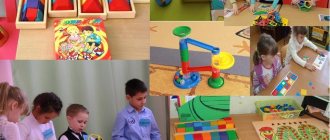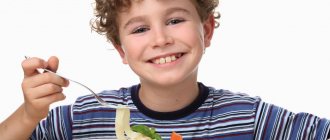Deviant behavior of preschool children. consultation
“Deviant behavior of preschool children”
What is deviance?
Deviance is a deviation from the norm. When this term is used to describe a child’s behavior, it means that his actions do not fit into the generally accepted framework and go beyond established norms.
Each scientific discipline defines the concept of deviant behavior in its own way:
- In social sciences, deviance is some social phenomena that pose a threat to the social and physical survival of a person in the immediate environment, a certain social environment. These phenomena disrupt the process of assimilation and reproduction of norms and values, and become an obstacle to self-development and self-realization in society.
- In medicine, deviant behavior is considered from the point of view of neuropsychic health.
- In psychology, deviant behavior in children is determined by an erroneous antisocial pattern of resolving conflict situations and complete ignorance of true reality, which leads to violation of accepted norms or harm to others and oneself.
Causes of abnormal child behavior
The reasons that cause deviations in a child’s behavior are so diverse and complex that it is almost impossible to single out one decisive one in each specific case. Most often, the background to deviant behavior is a complex of problems: social and biological factors, features of the child’s physiological and mental development, and the specifics of the environment.
Medical and biological reasons
This group of reasons is divided into three main subgroups:
- congenital;
- hereditary;
- acquired reasons.
Congenital causes are caused by intrauterine damage to the fetus during pregnancy. This could be: toxicosis, the consequences of drug intoxication, somatic and chronic infectious diseases of the expectant mother (especially at the beginning of pregnancy), her poor nutrition and unhealthy lifestyle (drinking alcohol or drugs, smoking).
Congenital causes influence the maturation of the nervous system, thereby influencing the individual characteristics of the baby and disrupting the mechanisms of voluntary regulation of behavior. As a result, the child’s natural mental development may slow down or change, which will aggravate age-related crises and lead to deviant behavior.
Hereditary causes are caused by damage to the genetic material: gene or chromosomal mutations, metabolic defects that affect the maturation of brain structures. This results in mental development disorders, physical defects, hearing or vision defects, and damage to the nervous system.
Hereditary characteristics explain the main characteristics of the nervous system of a small person, on which temperament, fatigue and ability to work, the child’s sensitivity to the environment, the ability to quickly adapt and establish contacts depend.
Acquired causes arise during the life of the baby. Along with the influence of heredity, the inferiority of the nerve cells of the brain, which is caused by severe illnesses of the child at an early age and traumatic brain injury, is also of no small importance.
Acquired causes also include somatic and nervous diseases, chronic diseases with repeated relapses. Long-term illnesses often become sources of neuroses, developmental delays, and provoke disobedience and aggression. They contribute to a decrease in the mental ability to master certain activities and interfere with establishing contacts with peers. As a result, the child’s personality and behavior are formed in a pathological manner. And after this it manifests itself in the child’s emotional instability, weakening of his adaptive and protective mechanisms.
Social reasons
First of all, the social causes of deviant behavior in young children and adolescents include a dysfunctional family environment. The concept of “family dysfunction” includes various negative characteristics: intrafamily relationships, defects in its quantitative, structural and age-gender composition, connections of household members with various external social institutions (for example, with representatives of a kindergarten).
Dysfunctional families, in which conditions are created for an increased risk of deviant behavior in the child, are divided into the following types:
- An incomplete family in which only the mother or father (or even the grandparents) are involved in raising the child. The educational capabilities of such a family are generated by pedagogical, moral, psychological and material factors. The absence of one of the parents is significant, since a child without a mother or father loses a whole world of emotional and moral relationships. But even an incomplete family with limited educational capabilities sometimes brings more benefits to the baby than a complete but defective one.
- A conflict family, which is characterized by psychological tension in relationships, lack of mutual understanding, differences in views, interests, needs, and attitudes. In such a family, peace is a temporary compromise. Frequent conflicts and psychological tension negatively affect the development of a child’s personality. Pathological marital relationships provoke many deviations in the child’s psyche, which results in especially pronounced forms of deviant behavior.
- In an asocial family, preference is given to antisocial tendencies and a parasitic lifestyle, and its members often commit illegal actions.
- In families with an “alcoholic lifestyle,” the main interest is the consumption of alcoholic beverages. Socially positive functions are not provided for in such a family.
- The difference between a formally prosperous family is that the needs and life goals of its members are scattered, there is no mutual respect. Necessary responsibilities (including raising a child) are performed formally.
Numerous studies have shown that dysfunctional families are characterized by the following types of inadequate parenting:
- hidden neglect (parents perform their duties purely formally);
- condoning neglect (adults do not criticize the child’s abnormal behavior in any way);
- excessive severity and exactingness towards the baby;
- emotional rejection;
- overprotection and excessive unreasonable admiration for the child.
An unfavorable family environment and inadequate methods of education, lack of a common language with parents, inability to establish relationships with others - all this can become a prerequisite for the manifestation of deviant behavior in a preschool child.
Pedagogical reasons
Often, adults who demand discipline from a child and adherence to a culture of behavior stumble upon the preschooler’s question “Why?” You need to answer in a timely and reasoned manner. If adults could not or did not want to explain to the child the essence of a certain requirement, the result is the formation of a distorted understanding of the child about generally accepted norms. The discrepancy between the statements of adults and the actual violation by them of these statements is a negative example for a child.
Another pedagogical reason is the abuse of prohibitions. If adults exceed restrictive measures, it is quite possible for the child to have a back defensive reaction in the form of abnormal behavior.
When adults do not fully take into account the individual, age and psychological characteristics of the child, the likelihood of errors in assessing his capabilities increases. And this leads to conflicts and abnormal manifestations of behavior.
Psychological reasons
In children of primary preschool age, behavioral deviations are manifested by outbursts of anger. The child can react very violently to the restriction imposed by the parents: squeal, start kicking or suffocate. If parents manage to ignore the whims and demands of the baby, learn to distract him in moments of childish rage, such undesirable manifestations will be overcome.
However, it should be noted that up to 5 years of age, such deviations in the behavior of children are considered within normal limits.
In older preschool age, the child learns what a “struggle of emotions” is. He understands this as a contradiction between the perception of his “I” and the assessments of others. At this age, parenting mistakes can lead to the baby being consumed by his own emotions. And this, in turn, becomes the cause of deviant behavior.
Correction and prevention of deviant behavior in preschool children
The main problems of children with deviant behavior are their inability to control themselves and interact effectively with others. In order to eliminate distortions in the emotional response and existing behavioral stereotypes, and rebuild the child’s full-fledged contacts with peers, the following solutions have been identified:
- Forming a child’s interest in the people around him and the desire to understand them.
- Strengthening communication skills and basic knowledge about the rules of behavior.
- Developing skills of adequate behavior.
- Teaching your child to correctly evaluate himself and balance his emotional states.
- Developing the ability to communicate in various situations through a variety of forms.
Behavior correction methods should be based on organizing activities that are interesting to the child. Since play is the leading type of activity for preschool children, for the development of the communicative and emotional sphere, as a rule, the following are used:
- communicative and outdoor games;
- acting out “difficult situations”;
- rhythmic games with words;
- playing music and dancing;
- reading and discussing fairy tales.
The last point deserves special attention. After all, fairy tales are very closely related to games, and therefore fairy tale therapy is one of the directions in the correction and prevention of deviant behavior in preschool children. Fairy tales help children form the concepts of “good” and “evil,” reveal their creative potential, and teach them to correctly evaluate the actions of both their own and those of others.
For a preschool child, a fairy tale has an extraordinary attractive power. She allows him to freely fantasize and dream. At the same time, a fairy tale for a child is not only fantasy and fiction, but also a special reality that expands the boundaries of everyday life. In a fairy tale, you can encounter complex feelings and phenomena, and comprehend the adult world of experiences in a form accessible to children’s understanding.
In addition, young children have a highly developed identification mechanism. In other words, the baby easily unites himself with a fairy-tale character, most often choosing a positive hero. The reason for this is not that the baby understands the full depth of human relationships. It’s just that if you compare the hero with other characters, the position of the hero attracts the baby more. Thanks to this, the child learns moral values and norms.
In addition to games and corrective activities, a child with deviant behavior needs a solid daily routine, proper nutrition, and control over the programs and films watched on TV. And parents need to be patient and understanding, and learn self-control.
Today's life is characterized by a revaluation of established values. And first of all, this concerns human relationships. Many pedagogical principles have been recognized as irrelevant, and new ones have not yet been fully formed. Some adults have an insufficient level of psychological and pedagogical culture, and children constantly become objects of not always successful teaching experiments. Ultimately, all this can lead to a wide variety of forms of deviant behavior in young children and, subsequently, adolescents.










